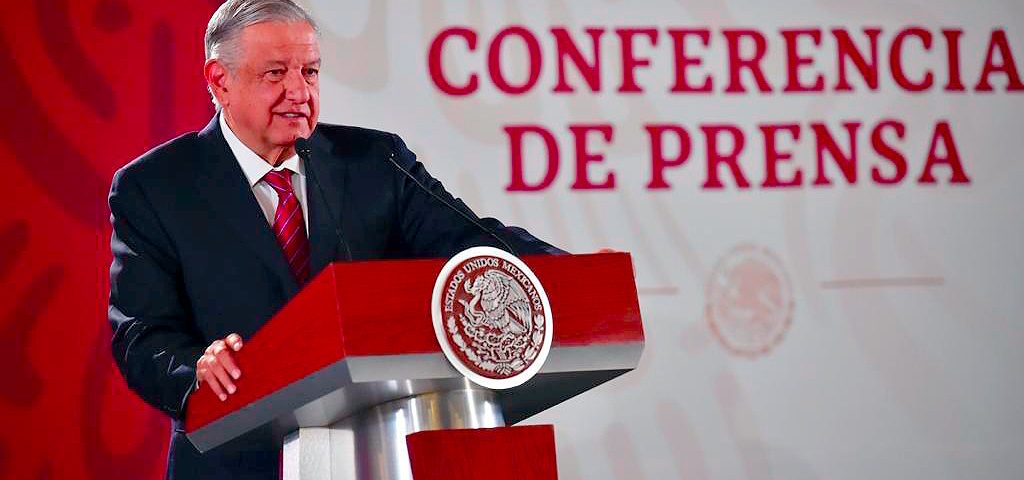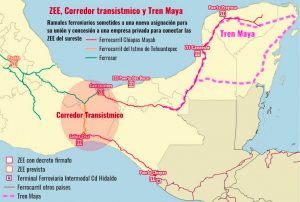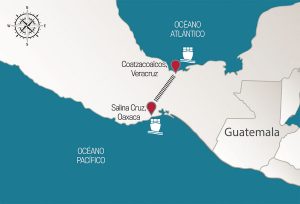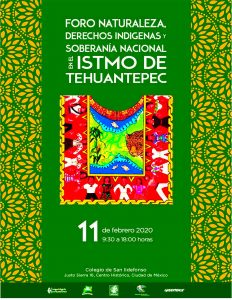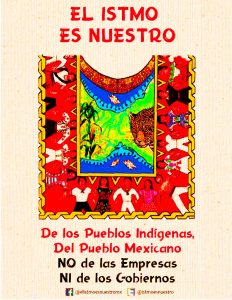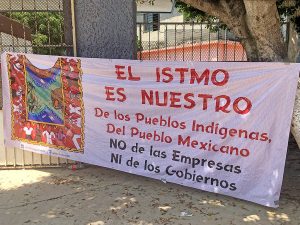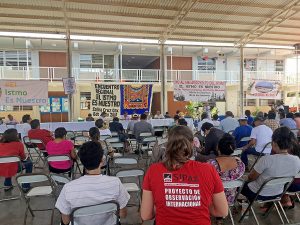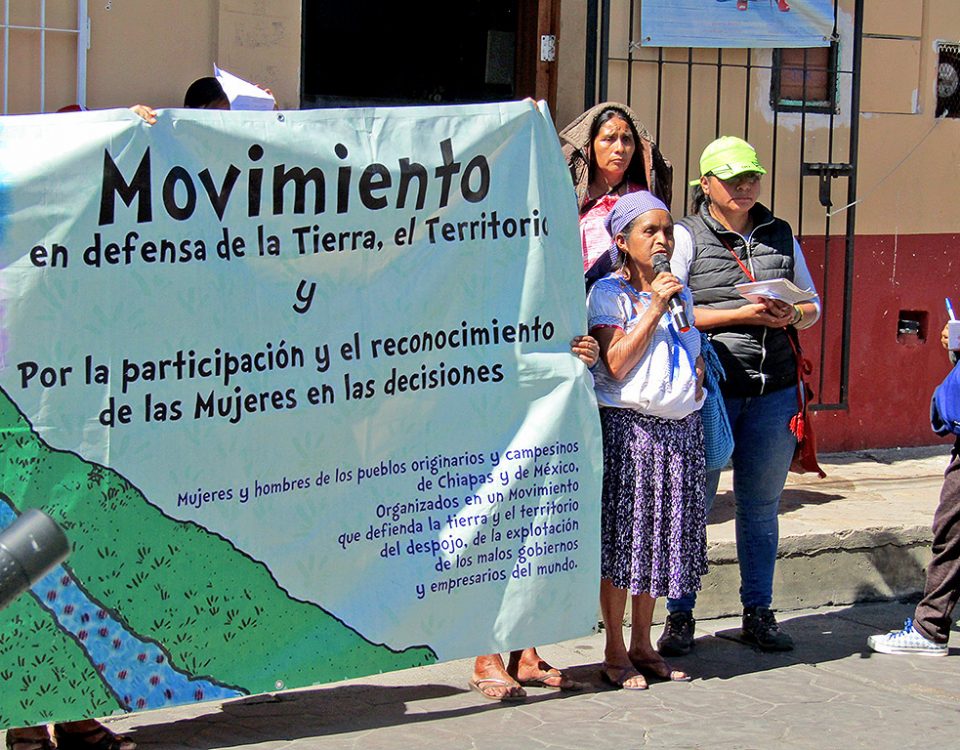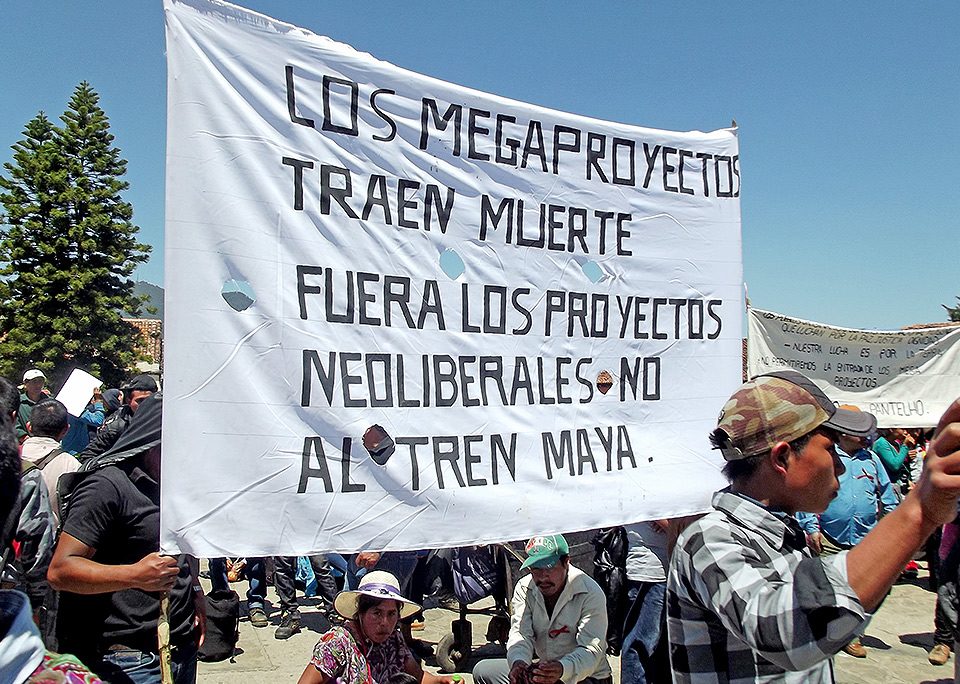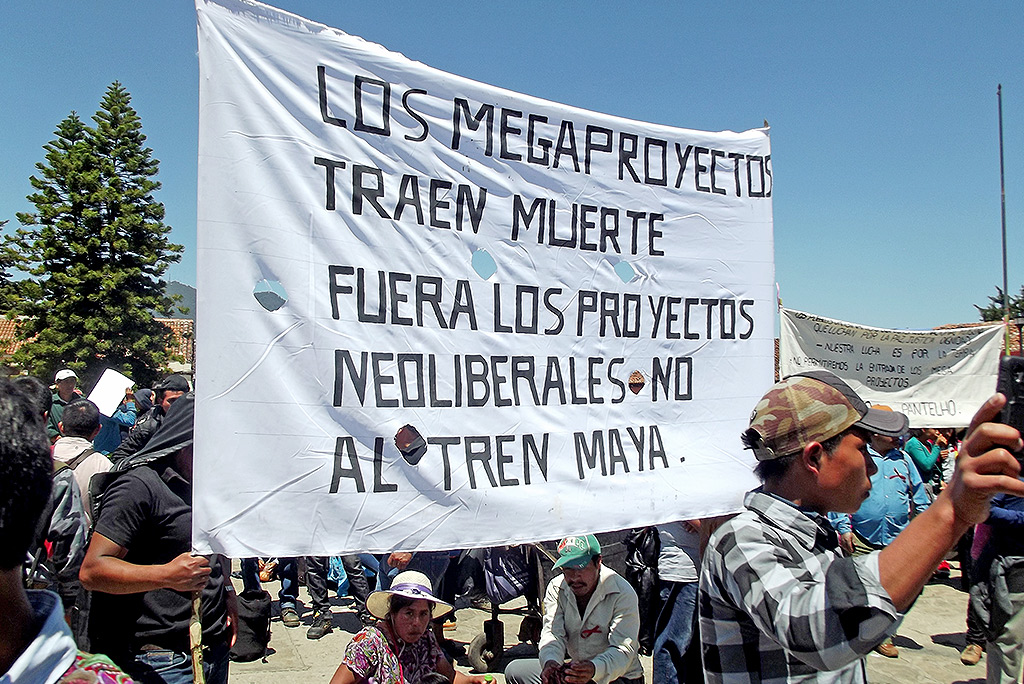
LATEST: Mexico – Perceptions and contradictions
06/03/2020
ARTICLE: 25th Anniversary of Civil Observation Brigades – “When solidarity becomes present”
06/03/2020During the first years of the 16th century, the Spanish conquistador Hernan Cortes made multiple expeditions to find the best way to move merchandise and raw materials to Spain. For this purpose, King Carlos V ordered that the three narrowest areas of the continent be examined: the Darien Gap, Nicaragua, and the Isthmus of Tehuantepec. In the end, no river connection for cargo ships between the two oceans was found in the isthmus.
North American interests: attempts to acquire the Isthmus
In the mid-nineteenth century, interest in the Isthmus of Tehuantepec re-emerged as a means of transporting goods, this time by the United States. They made several attempts to appropriate the territory, beginning with the signing of the Tehuantepec Treaty in 1850. In this agreement, the Mexican government promised to give guarantees to the Tehuantepec Railway Company to carry out a railway project through the Isthmus of Tehuantepec and protect the business and its employees during construction. However, the treaty was annulled two years later, and the technicians who were surveying of the area were forced to leave the country.
The Mexican rail system under Porfirio Diaz
The economic strategy of Porfirio Diaz (1876-1911) focused on granting endless concessions to European businessmen, thus seeking prosperity and a counterweight to the intimidation of the United States. Among others, he hired Weetman Pearson of the London company Pearson and Sons to build the Port of Mexico, which today is named after Coatzacoalcos. Pearson was also hired for the construction of the Veracruz-CDMX railroad, and the remodeling of the Tehuantepec railway, whose works had begun in 1859, and which were finally inaugurated in 1907.
After the economic boom generated by Diaz’s foreign policy, although without benefits for Mexicans, a period of crisis followed, influenced among other things, by the opening of the Panama Canal in 1914, which “monopolized most of the cargo that previously passed through the Isthmus”, and devalued the area as an interoceanic route.
Reviving and formalizing the idea of the interoceanic route
Although during the presidency of Gustavo Diaz Ordaz (1964-1970) the revival of the railways of the Isthmus of Tehuantepec was considered, it was not until the 1990s with the government of Ernesto Zedillo (1994-2000) that the plans began to formalize. While there was talk of an expansion of the Panama Canal, Zedillo proposed the Comprehensive Economic Development Program in the Isthmus of Tehuantepec, which provided for the development of 11 sectors, including the Interoceanic Transportation Corridor from Salina Cruz, Oaxaca, to Coatzacoalcos, Veracruz, in order to integrate the region into world development.
His successor, Vicente Fox (2000-2006), presented the Puebla-Panama Plan, which was signed in March 2001 and intended to cover the Mexican states of Puebla, Veracruz, Tabasco, Campeche, Yucatan, Quintana Roo, Guerrero, Oaxaca, and Chiapas, as well as Guatemala, Belize, Honduras, El Salvador, Costa Rica, and Panama. It tried to improve the infrastructure of the area through the construction and remodeling of roads, railways, airports, ports, hydroelectric plants, and oil facilities. Its intention was to generate jobs through the implementation of micro-industries and the promotion of joint development plans and strategies between the South-Southeast of Mexico and Central American countries.
In 2007, during the presidency of Felipe Calderon (2006-2012), the Logistics System of the Isthmus of Tehuantepec was announced. It sought to implement a multimodal channel that would complement the Panama Canal through the modernization of roads, railways, and ports on the Isthmus.
None of the three projects succeeded, either because of economic conditions or for other reasons, one of them being the indigenous resistance in the Isthmus. Milenio magazine estimates that more than 15 billion dollars have been lost in the last 35 years due to resistance actions against the implementation of projects in the region, to the extent that it considers the area a “cemetery of projects.”
With Enrique Peña Nieto (2012-2018) and his Isthmus Door to America Plan, the proposed project was further expanded. This plan sought not only the transportation of goods but also the export of raw materials out of Mexico. In 2016, Peña Nieto presented the Special Economic Zones (SEZs), which, through industrialization, sought to reduce poverty by allowing access to basic services.
With the SEZs, the establishment of an industrial corridor was planned in order to connect the Pacific and Mexican Gulf coasts. Seven SEZs were established throughout the country: Lazaro Cardenas-La Union (Michoacan and Guerrero), Coatzacoalcos (Veracruz), Salina Cruz (Oaxaca), Puerto Chiapas (Chiapas), Progreso (Yucatan), Seybaplaya (Campeche), and Dos Bocas (Tabasco). The Isthmus of Tehuantepec project appeared to be in the first stages of development; in 2018 the federal Chamber of Deputies allocated 100 million pesos to start the project.
In April 2019, the new Mexican president, Andres Manuel Lopez Obrador (AMLO), announced the “disappearance” of the SEZs, considering that they had not fulfilled their goal. He justified his decision stating, “It was supposedly to help, but they never did anything to help; they did business, bought land, and wasted resources.” He clarified that his administration would prioritize regional development projects such as the Mayan Train, the Dos Bocas refinery, and the Trans-Isthmus Corridor.
The Transistmic Project today
Five centuries after the plans of Carlos V, on June 14, 2019, a decree was issued that gave birth to the so-called Program for the Development of the Isthmus of Tehuantepec, promoted by the AMLO government. The main axis of the project will be the Interoceanic Multimodal Corridor that seeks to realize what many had planned before: the transportation of merchandise between the two oceans through the Isthmus of Tehuantepec. The Program will include the construction of different means of transportation and the expansion of industry in the region in order to compete in world markets.
In a letter addressed to the US President in the summer of 2018, AMLO mentioned his plan for the first time: “An economic and commercial corridor will be created in the Isthmus of Tehuantepec. […] It is a 300-kilometer corridor where a railway line for container transport will be built. This project implies taking advantage of the strategic location of this strip of national territory to unite the Pacific with the Atlantic, thus facilitating the transport of goods between the countries of Asia and the east coast of the United States.”
Rafael Marin Mollinedo, appointed General Director of the Trans-Isthmus Project and previously responsible for the Special Economic Zones, highlighted the development of the Isthmus of Tehuantepec as “an urgent task”, due to its “economic lag and social marginalization.”
The future of the Isthmus of Tehuantepec according to the government
On December 23, 2018, the project was officially presented to the public during a tour conducted by the Mexican president in Oaxaca. He affirmed that one of the main objectives must be to promote a new model of economic growth, the conservation of biodiversity, water, soil, and air, as well as the reinforcement of the culture and regional identity of indigenous peoples.
According to the government’s proposal, the Isthmus of Tehuantepec Interoceanic Corridor will be the “backbone” of the Isthmus Development Program. First, the project of previous years will be resumed: a railway line between the ports of Salina Cruz, Oaxaca and Coatzacoalcos, Veracruz. The proposal intends to modernize this 304 km railway, and rectify some curves and slopes, in order to increase speed from 40 to 60-80 km/h. The modernization works alone will take about three years. In addition, they want to expand the ports on the respective coasts, in order to receive cargo ships. Another part of the project will be the construction of a new highway along the corridor, the modernization of the MEX-185 highway, and other roads.
In regards to industry, the project plans to increase the production of petroleum derivatives through the rehabilitation of the Minatitlan and Salina Cruz refineries, and improved maintenance of the 220 km pipeline that would transport natural gas that must supply the industries and communities in the region. To guarantee an electricity supply and provide communications to the industries and communities of the Isthmus, the development of wind power plants is intended, including the construction of five electrical substations and the installation of underground optical fiber. It was also announced that in 2020, the Isthmus of Tehuantepec will be declared a free zone, meaning that taxes will be lowered for companies in that territory and that there will be fiscal support to attract investments that generate jobs.
Mollinedo described the Interoceanic Corridor as “the spearhead” for more projects based around it. These include six other industrial parks along the corridor. There, raw materials can be transformed in order to generate added value and strengthen the economy. Alejandro Murat, governor of the state of Oaxaca, expressed that “this project means for Oaxaca and southeastern Mexico what the Free Trade Agreement did at the time. […] Oaxaca is celebrating.”
Objectives and intentions: “Development curtains”
Rafael Marin Mollinedo believes that the main causes of economic lag and poverty in the Isthmus have to do with low and declining levels of public and private investment, as well as weak local markets and fragile and poorly diversified economic structures. The modernization and construction of physical and digital infrastructure is intended to attract private investment, so that the State can “direct the economy and orient it towards the generation of welfare” for the population. Mollinedo says that those who will benefit most from the project are the most vulnerable and least favored groups of the population.
As AMLO had already mentioned in his letter to Donald Trump, one of the objectives of the project is the creation of jobs in order to keep the population in the region and prevent “young people from the region continuing to emigrate north in search of work.” It should be noted that the free zone of the Isthmus of Tehuantepec coincides with the containment zone defined in the Southern Border Program for immigration control. The National Development Plan of the current government seeks that “regional development projects act as “curtains” to capture the migratory flow in its transit to the north.”
In terms of logistics, it should be mentioned that the transport of goods by the interoceanic route of the Isthmus of Tehuantepec would be much faster than crossing the Panama Canal, where one must wait about ten days. “The Panama Canal is saturated, so this can be a relief valve for the demand that exists and has not been able to be served in the Panama Canal,” Mollinedo said.
The Transistmic Corridor in relation to other megaprojects
The Transistmic Corridor is closely related to other megaprojects such as the Mayan Train or the Dos Bocas refinery. They represent the three main projects of the AMLO government for the South and whose operation was thought out in an interconnected manner.
Dos Bocas will be built in the state of Tabasco, finishing in 2022, in order to extract oil (84% of proven oil reserves in all of Mexico are in this area.) The Mayan Train will pass along the Yucatan Peninsula from Cancun to Palenque, functioning as a tourist attraction during the day and as a freight train at night. Together with the Trans-Isthmus Corridor they combine the extraction and commodification of resources with the export to the markets of Asia, Europe, and the United States.
Geocomunes emphasizes that companies established in the free zone of the Isthmus of Tehuantepec will have “control of the right of way” over their territories which will allow them to “limit the mobility of people according to their interests.” According to Geocomunes, this means that “this particular region would be the starting point in the New South Frontier.”
Indigenous consultations questioned
When the project was announced, Rafael Marin Mollinedo said that one of the basic criteria will be respect for the opinion of the communities and indigenous peoples of the Isthmus. He promised to “do nothing without consultation” but also said he was sure “that people will support this project.”
In November 2018, a citizen consultation had already been carried out in which around 946,000 Mexicans participated nationwide, who decided on ten projects of the MORENA government. The Isthmus of Tehuantepec train received 90% support.
The Indigenous Consultation of the indigenous peoples of the Isthmus of Tehuantepec was held on March 30 and 31, 2019. At the end of April, AMLO said that “the consultation has already been done and people are in favor of the Trans-Isthmus Project; because people do want work and well-being.” He stated that 3,397 people had participated (there are more than one million indigenous people living in the Isthmus region). Community activists and advocates criticized that only some community representatives were invited, and that most of the representatives were consulted under pressure that their construction projects and other needs could not be granted if they did not approve the railroad project first.
“You cannot approve any megaproject without discussing in assembly without knowing what the positive and negative impacts will be,” said Carlos Beas, adviser to the Union of Indigenous Communities for the Northern Zone of the Isthmus (UCIZONI). He added that “there is no specific information regarding the megaproject of the Isthmus” and also considered it serious that “the populations consulted were 80km away from the project, but those at the foot of the railway were not consulted.”
Between August 19 and 30 of last year, the Federal Government held meetings under the Agrarian Attorney and Rafael Marín Mollinedo in the 31 ejido nuclei where the section of the trans-Isthmus train will pass. During these meetings the ejidatarios were informed about the megaproject and its impacts in just 15 minutes. The UCIZONI leader, Juana Ramirez Villegas, denounced that the information shared with those affected by the project was “vague and general.”
The Isthmus of Tehuantepec is an area of strong community organization in defense of land and territory as apart from the Trans-Isthmus Corridor there are 47,000 hectares of concessions for mining companies and 28 wind farms in the region. UCIZONI, being just one of many organizations that demonstrated against the megaproject, currently brings together 84 communities and colonies from nine municipalities in the state of Oaxaca in the Isthmus of Tehuantepec.
The National Indigenous Congress (CNI) and the Zapatista Army of National Liberation (EZLN) rejected the consultation one day after its completion, considering it “a simulation to impose the megaproject of death.” With “The Isthmus is Ours” campaign, the indigenous peoples of the Isthmus expressed their “resounding rejection” of the megaproject through a pronouncement launched in April 2019.
The megaproject will affect 80 municipalities of the Isthmus, 49 in the state of Oaxaca and 31 in Veracruz, mostly populated by indigenous people from Chontal, Huave, Mixes, Zapotecs, Zoques, Nahuas, and Popolucas. It is also worth mentioning that the Isthmus of Tehuantepec is one of the regions of Mexico and the world that still houses between 30% and 40% of the biodiversity of the entire planet. It is a source of 40% of the national water supply and holds three rain forests of the country- deciduous, sub-humid, and humid. Given the great wealth of the region, it is important to carry out and present studies on the environmental effects caused by the Trans-Isthmus Corridor.
After the indigenous consultation, AMLO accused his adversaries saying, “what they want is to keep stealing, that is what they care about and that is why they want us to do badly, but they are going to keep wanting.” Environmental and human rights defenders denounced that their work is ignored because they are presented as “conservatives” opposed to “progress,” which may put them at greater risk. “They face systematic attacks such as criminalization, defamation, harassment, arbitrary detentions, and murders,” said the Consortium for Parliamentary Dialogue and Equity, a feminist civil organization in Oaxaca.
Horizons
The members of UCIZONI have stressed that the consultations carried out in March and August 2019 have not met the standards stipulated in Convention 169 of the International Labor Organization (ILO), according to which indigenous consultations must be prior, free, informed, and culturally appropriate. In January 2020, UCIZONI filed a complaint with the National Human Rights Commission (CNDH) for violation of the rights of indigenous peoples. Dagoberto Toribio, president of UCIZONI, said regarding the query that “the information was insufficient and biased, was not prior and was not free because the acceptance of the Trans-Isthmus Corridor megaproject was obtained in exchange for receiving social programs.”
They demanded that the Ministry of the Environment Natural Resources (SEMARNAT) hold another public consultation on the ecological impact of the modernization of the railway. In the forum “Nature, Indigenous Rights, and National Sovereignty in the Isthmus of Tehuantepec” that took place on February 11 of this year, the head of the Semarnat, Víctor Manuel Toledo, emphasized that although the government is considering “respect to biocultural wealth”, “the trains will go ahead.”
Sources:
- El Tren Maya. Un nuevo proyecto de articulación territorial en la Península de Yucatán
- Tren Maya como nueva infraestructura de articulación de los capitales agroindustriales y turísticos inmobiliarios en la península
- DECRETO por el que se crea el Corredor Interoceánico del Istmo de Tehuantepec.
- PLAN Nacional de Desarrollo 2019-2024.
- Palabras del Lic. Rafael Marín Mollinedo, en la Presentación del Programa para el Desarrollo del Istmo de Tehuantepec
- Programa para el Desarrollo del Istmo de Tehuantepec (PDIT)
- Animal Político: AMLO anuncia inversión de 8 mil mdp para el proyecto del Istmo de Tehuantepec; obras iniciarán en 2019
- Istmopress: El Corredor Transístmico, la historia inconclusa
- Sinembargo: Somos los dueños de la tierra y del Corredor Transístmico ni nos informan, dicen en Juchitán
- Razon.com: Historia del Corredor Transístmico
- Poresto.net: Zedillo privatizó sistema ferroviario de México
- La Jornada: El Istmo es nuestro
- La Jornada: Corredor transístmico
- Newsweek México: Corredor Transístmico: a recuperar el auge económico
- Plumasatomicas: A pregunta de la consulta de Corredor Transístmico, AMLO responde: ‘la verdad es de Cristo’
- Somoselmedio: Consulta del proyecto Corredor Transístmico, una simulación: EZLN
- Desinformemonos: Consultas para aprobar Corredor Transístmico han sido “amañadas”: UCIZONI
- Informador: Corredor Transístmico, sometido a consulta: López Obrador
- Animal Político: “Se les fue”: AMLO dice que ya consultó a indígenas sobre corredor transístmico; dará resultados mañana
- La Jornada: Rechazan ONG consultas sobre corredor transístmico y megaproyecto eólico
- La Coperacha: Planean en el Istmo 6 parques industriales y zona libre; hay respaldo de comunidades, según Gobierno Federal
- Amauri Vierira Orozco: Corredor Transístmico de Tehuantepec como alternativa al Canal de Panamá
- La Jornada Veracruz: Zonas Económicas Especiales
- Expansión: Esta es la carta completa que envió López Obrador a Trump
- Teresa de Jesús Portador García: Claroscuros en el futuro energético de América Latina: el corredor eólico en el Istmo oaxaqueño
- El Economista: AMLO pone fin a Zonas Económicas Especiales
- La Jornada Maya: El Corredor Transístmico viola derechos de indígenas, acusa Ucizoni
- El Universal: Pueblos indígenas de Oaxaca denuncia “consultas de 15 minutos” sobre Tren Transístmico
- El Universal: Pueblos presentan queja ante CNDH por consulta sobre Proyecto Transístmico

